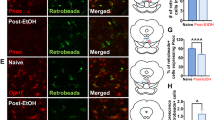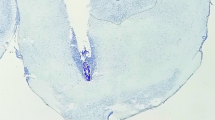Abstract
The NMDA receptor has been implicated in opioid tolerance and withdrawal. The effects of continuous infusion of butorphanol on the modulation of NMDA receptor subunit NR1, NR2A, NR2B, and NR2C gene expression were investigated by using in situ hybridization technique. Continuous intracerebroventricular (i.c.v.) infusion with butorphanol (26 nmol/μl/h) resulted in significant modulations in the NR1, NR2A, and NR2B mRNA levels. The level of NR1 mRNA was significantly decreased in the cerebral cortex, thalamus, and CA1 area of hippocampus in butorphanol tolerant and withdrawal (7 h after stopping the infusion) rats. The NR2A mRNA was significantly decreased in the CA1 and CA3 of hippocampus in tolerant rats and increased in the cerebral cortex and dentate gyrus in butorphanol withdrawal rats. NR2B subunit mRNA was decreased in the cerebral cortex, caudate putamen, thalamus, CA3 of hippocampus in butorphanol withdrawal rats. No changes of NR1, NR2A, NR2C subunit mRNA in the cerebellar granule cell layer were observed in either butorphanol tolerant or withdrawal rats. Using quantitative ligand autoradiography, the binding of NMDA receptor ligand [3H]MK-801 was increased significantly in all brain regions except in the thalamus and hippocampus, at the 7 hr after stopping the butorphanol infusion. These results suggest that region-specific changes of NMDA receptor subunit mRNA (NR 1 and NR2) as well as NMDA receptor binding ([3H]MK-801) are involved in the development of tolerance to and withdrawal from butorphanol.
Similar content being viewed by others
REFERENCES
Hoover, R. C. and Williams, R. B. 1985. Survey of butorphanol and nalbuphine diversion in U.S. hospitals. Am. J. Hosp. Pharm. 42:1111–1113.
Smith, S. G. and Davis, W. M. 1984. Nonmedical use of butorphanol and diphenylhydramine. J. Am. Med. Assoc. 252:1010.
Evans, W. S., Bowen, J. N., Giordano, F., and Clark, B. 1985. A case of stadol dependence. J. Am. Med. Assoc. 253:2191–2192.
Brown, G. R. 1985. Stadol dependence: another case. J. Am. Med. Assoc. 254:910.
Chang, K. J., Wei, E. T., Killian, A., and Chang, J. K. 1983. Potent morphiceptin analogs: structure activity relationships and morphine-like activities. J. Pharmacol. Exp. Ther. 227:403–408.
Lahti, R. A., Mickelson, M. M., McCall, J. M., and Von Voightlander, P. F. 1985. [3H]U-69,593: a highly selective ligand for the opioid κ receptor. Eur. J. Pharmacol. 109:281–284.
Jaw, S. P., Hoskins, B., and Ho, I. K. 1993. Opioid antagonists and butorphanol dependence. Pharmacol. Biochem. Behav. 44:497–500.
Jaw, S. R., Hoskins, B., and Ho, I. K. 1993. Involvement of δ-opioid receptors in physical dependence on butorphanol. Eur. J. Pharmacol. 240:67–72.
Jaw, S. P., Makimura, M., Hoskins, B., and Ho, I. K. 1993. Effect of norbinaltorphimine on butorphanol dependence. Eur. J. Pharmacol. 239:133–140.
Coutinho-Netto, J., Abdul-Ghani, A., and Bradford, H. F. 1980. Suppression of evoked and spontaneous release of neurotransmitters in vivo by morphine. Biochem. Pharmacol. 29:2777–2780.
Crowder, J. M., Norris, D. K., and Bradford, H. F. 1986. Morphine inhibition of calcium fluxes, neurotransmitter release and protein and lipid phosphorylation in brain slices and synaptosomes. Biochem. Pharmacol. 35:2501–2507.
Gannon, R. L. and Tertian, D. M. 1991. U-50,488H inhibits dynorphine and glutamate release from guinea pig hippocampal mossy fiber terminals. Brain Res. 548:242–247.
Nicol, B., Rowotham, D. J., and Lambert, D. G. 1996. μ-and κ-Opioids inhibit K+evoked glutamate release from rat cerebrocortical slices. Neurosci. Lett. 218:79–82.
Aghajanian, G. K., Kogan, J. H., and Moghaddam, B. 1994. Opiate withdrawal increases glutamate and aspartate efflux in the locus coeruleus: an in vivo microdialysis study. Brain Res. 636:126–130.
Zhang, T., Feng, Y. Z., Rockhold, R. W., and Ho, I. K. 1994. Naloxone-precipitated morphine withdrawal increases pontine glutamate levels in the rat. Life Sci. 55:PL25–PL31.
Feng, Y. Z., Zhang, T., Rockhold, R. W., and Ho, I. K. 1995. Increased locus coeruleus glutamate levels are associated with naloxone-precipitated withdrawal from butorphanol in the rat. Neurochem. Res. 20:745–751.
Taylor, C. P., Geer, J. J., and Burke, S. P. 1992. Endogenous extracellular glutamate accumulation in rat neocortical cultures by reversal of the transmembrane sodium gradient. Neurosci. Lett. 145:197–200.
Koyuncuoglu, H., Gungor, M., Sagduyu, H., and Aricioglu, F. 1990. Suppression by ketamine and dextromethorphan of precipitated abstinence syndrome in rats. Pharmacol. Biochem. Behav. 35:829–832.
Rasmusssen, K., Fuller, R. W., Stockton, M. E., Perry, K. W., Swinford, R. M., and Ornstein, P. L. 1991. NMDA receptor antagonists suppress behaviors but not norepinephrine turnover or locus coeruleus unit activity induced by opiate withdrawal. Eur. J. Pharmacol. 117:9–16.
Koyuncuoglu, H., Dizdar, Y., Aricioglu, F., and Sayin, U. 1992. Effects of MK-801 on morphine physical dependence: attenuation and intensification. Pharmacol. Biochem. Behav. 43:487–490.
Tokuyama, S., Wakabayashi, H., and Ho, I. K. 1996. Direct evidence for a role of glutamate in the expression of opioid withdrawal syndrome. Eur. J. Pharmacol. 295:123–129.
Zhu, H. and Ho, I. K. 1998. NMDA-R1 antisense attenuates morphine withdrawal behaviors. Eur. J. Pharmacol. 352: 151–156.
Monyer, H., Sprengel, R., Schoepfer, R., Herb, A., Higuchi, M., Lomeli, H., Burnashev, N., Sakmenn, B., and Seeberg, P. H. 1992. Heteromeric NMDA receptors: molecular and functional distinction of subtypes. Science 256:1217–1221.
Paxinos, G. and Watson, C. 1986. The rat brain in storeotaxic coordinates, 2nd edit., Academic Press, Orland, Florida.
Horan, P. and Ho, I. K. 1991. The physical dependence liability of butorphanol: a comparative study with morphine. Eur. J. Pharmacol. 203:387–391.
Sakurai, S. Y., Penny, J. B., and Young, A. B. 1993. Regionally distinct N-methyl-D-aspartate receptors distinguished by quantitative autoradiography of [3H]MK-801 binding in rat brain. J. Neurochem. 60:1344–1353.
Moriyoshi, K., Masu, M., Ishii, T., Shigemoto, R., Mizuno, N., and Nakanishi, S. 1991. Molecular cloning and characterization of the rat NMDA receptor. Nature 354:31–37.
Ishii, T., Moriyoshi, K., Sugihara, H., Sakurada, K., Kadotani, H., Yokoi, M., Akazawa, C., Shigemoto, R., Mizuno, N., Masu, M., and Nakanishi, S. 1993. Molecular characterization of the family of the N-methyl-D-aspartate receptor subunits. J. Biol. Chem. 268:2836–2843.
Laurie, D. J. and Seeburg, P. H. 1994. Ligand affinities at recombinant N-methyl-D-aspartate receptors depend on subunit composition. Eur. J. Pharmacol. Mol. Pharmacol. Sect. 268: 335–345.
Zhu, H., Jang, C. G., Ma, T., Oh, S., Rockhold, R. W., and Ho, I. K. 1999. Region specific expression of NMDA receptor NR1 subunit mRNA in hypothalamus and pons following chronic morphine treatment. Eur. J. Pharmacol. 365:47–54.
Wenzel, A., Fritschy, J. M., Mohler, H., and Benke, D. 1997. NMDA receptor heterogeneity during postnatal development of the rat brain: differential expression of the NR2A, NR2B, and NR2C subunit proteins. J. Neurochem. 68:469–478.
Resink, A., Villa, M., Benke, D., Mohler, H., and Balazs, R. 1995. Regulation of the expression of NMDA receptor subunit in rat cerebellar granule cells: effect of chronic K+-induced depolarization and NMDA exposure. J. Neurochem. 64:558–565.
Author information
Authors and Affiliations
Rights and permissions
About this article
Cite this article
Oh, S., Kim, JI., Chung, MW. et al. Modulation of NMDA Receptor Subunit mRNA in Butorphanol-Tolerant and —Withdrawing Rats. Neurochem Res 25, 1603–1611 (2000). https://doi.org/10.1023/A:1026618603795
Issue Date:
DOI: https://doi.org/10.1023/A:1026618603795




